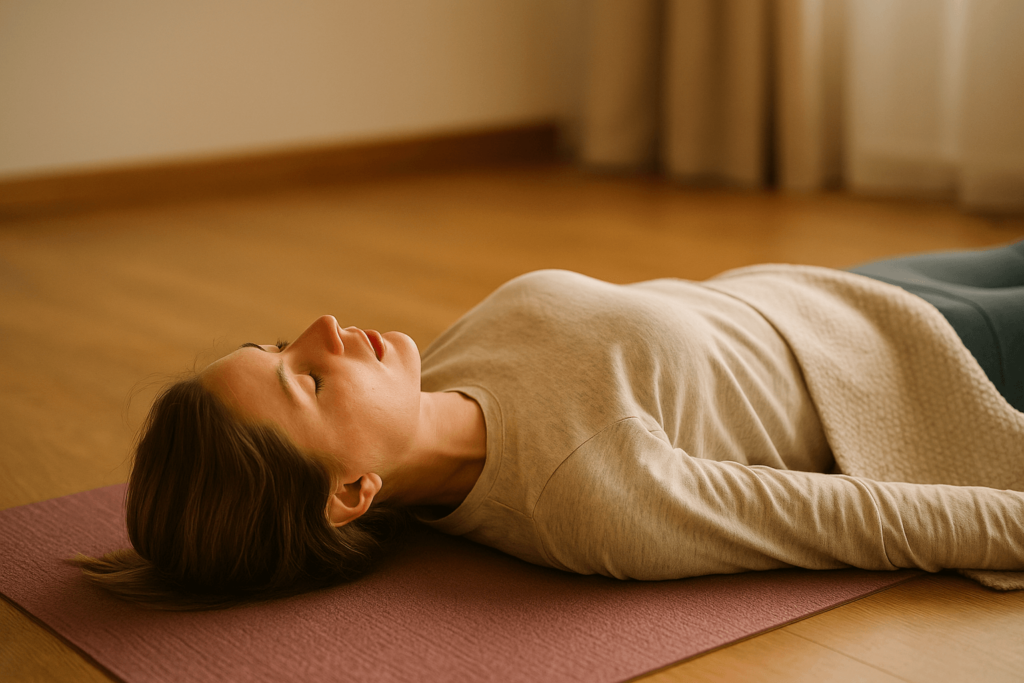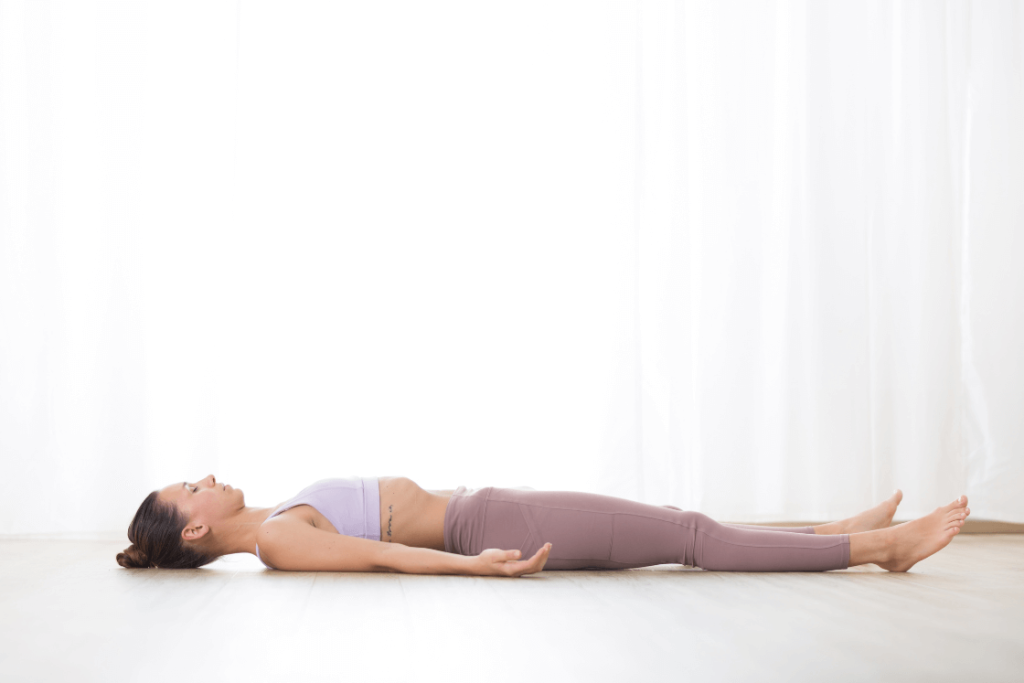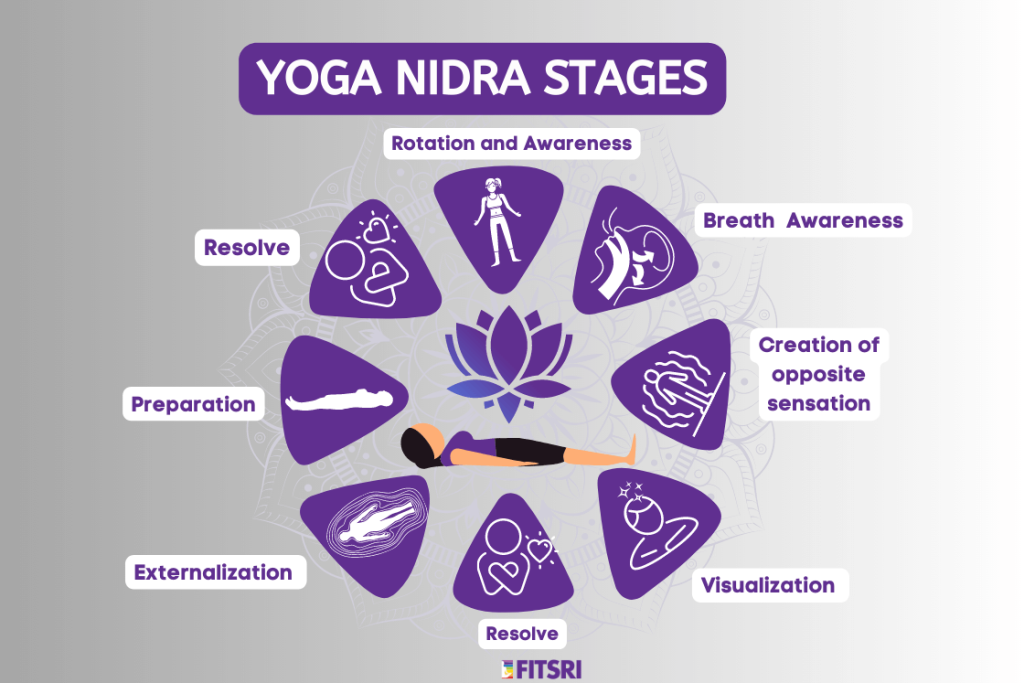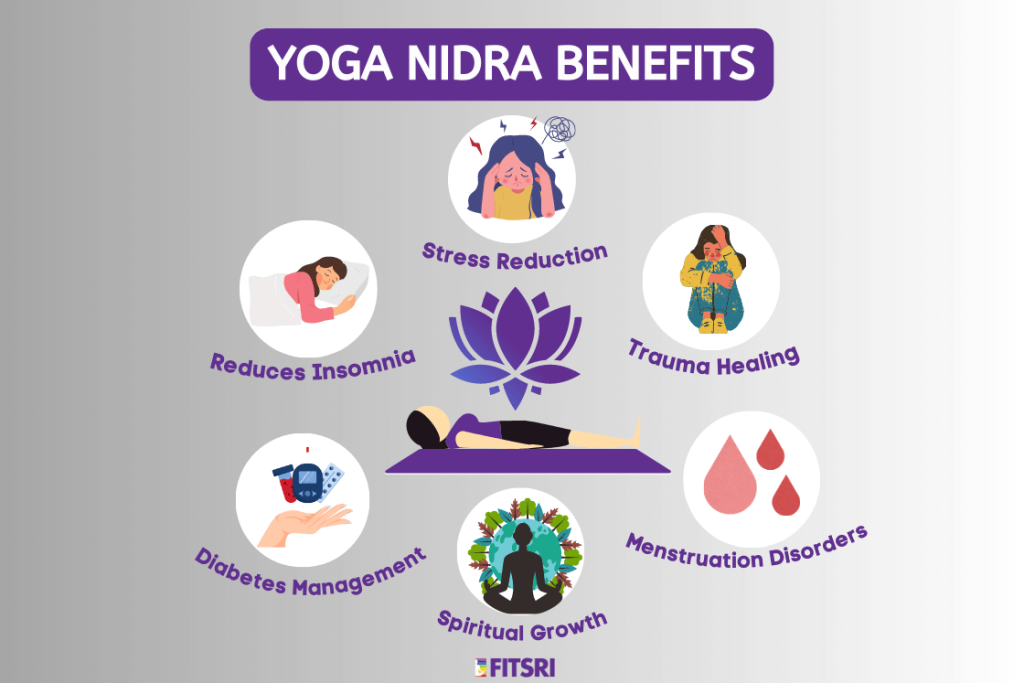- Concept
- Origin
- 8 Stages
- Step-by-step practice
- Yoga Nidra vs. Meditation
- Working
- Scientific Benfits
- Precautions
- Conclusion
- FAQs

When we think of yoga, we usually imagine stretches, twists, and calm breathing on the mat. But yoga is much more than physical postures. It’s also a way to relax the body and quiet the mind so both can work in harmony.
In modern life, the body may rest, but the mind often does not. Even when we lie down at night, thoughts continue running unfinished tasks, worries, and plans for the next day. This constant mental activity drains our energy and affects the quality of our rest.
Yoga Nidra, sometimes called yogic sleep, offers a different kind of relaxation. During this practice, the body becomes completely still while the mind remains calm and aware. You enter a natural state between wakefulness and sleep that feels deeply restful yet conscious.
It is a simple guided practice that does not require physical effort. You only need to lie down and follow gentle instructions, allowing layers of stress to melt away from both body and mind.
Even a short session can make you feel relaxed, light, and refreshed- similar to the feeling of waking up from deep, nourishing sleep. With regular practice, this sense of ease slowly appears in daily life, bringing clarity, balance, and peace.
Yoga Nidra is the art of conscious relaxation. It reminds us that true rest begins when the mind learns to soften and let go.
🧘♀️ 2. Meaning and Concept of Yoga Nidra

Yoga Nidra” is a Sanskrit term made of two words: Yoga, which means union, and Nidra, which means sleep. Together, the phrase describes a state where the body rests as if asleep, while the mind stays quietly aware. This is why Yoga Nidra is often understood as conscious sleep or deep relaxation with awareness
In normal sleep, the body rests but awareness disappears. In Yoga Nidra, awareness remains present even as the body moves into deep rest. This simple shift staying attentive while the body relaxes- creates a level of calmness that ordinary sleep seldom provides.
The practice is guided through gentle instructions. As you listen to the teacher’s voice, your attention moves through different parts of the body, the breath, and subtle sensations. With each step, the senses gradually withdraw from the outer world. In yoga, this inward movement is called Pratyahara, the fifth limb of Patanjali’s Ashtanga Yoga.
This turning inward settles the mind and creates space for stillness. Many practitioners describe it as resting in a quiet place between wakefulness and dreaming.
Swami Satyananda Saraswati, who brought Yoga Nidra into modern practice, often said that one hour of Yoga Nidra can feel as refreshing as several hours of ordinary sleep. The purpose is not only to relax the body but to awaken a deeper inner awareness – a place where healing, clarity, and peace naturally arise.
💡 Did You Know?
In Yoga Nidra, the mind stays awake while the body sleeps. This unique balance of relaxation and awareness is why it’s sometimes called dynamic sleep.
Join Our 7-Day Yoga Nidra Workshop
🕉️ 3. Origin and Historical Background of Yoga Nidra
The roots of Yoga Nidra stretch back to the ancient traditions of India. The idea of remaining aware while the body rests appears in early yogic and tantric teachings, where sages explored how consciousness can stay awake even in deep relaxation.
Hints of this state are found in the Upanishads, especially the Mandukya Upanishad, which describes four levels of consciousness: waking, dreaming, deep sleep, and Turiya – the silent, ever-present awareness behind all experiences. Yoga Nidra is often understood as a path that helps the practitioner touch this quiet inner state while lying in deep rest.
Another early reference appears in the Mahabharata, where Lord Vishnu is described as resting in Yoga Nidra on the cosmic ocean. This image represents a state of calm, balanced awareness that supports the entire universe – rest that is not unconscious, but steady and awake from within.
In the Tantric tradition, practices called Nyasa (meaning “to place” or “to touch”) were used to bring awareness into specific parts of the body. These methods of directing attention through the body formed an early foundation for what later evolved into the modern practice of Yoga Nidra.
In the 20th century, Swami Satyananda Saraswati of the Bihar School of Yoga organised and taught Yoga Nidra as a structured, guided practice. Drawing from these ancient ideas, he shaped it into a method that anyone can follow, regardless of age, background, or physical ability.
Because of his work, Yoga Nidra spread across the world and became known as a simple yet powerful way to relax the body, quiet the mind, and access deeper layers of awareness. Today, it is used not only in yoga settings but also in hospitals, therapy programmes, and schools for its calming and restorative benefits.
📜 From the Mahabharata
“At the end of each cosmic age, Lord Vishnu rests upon the ocean in Yoga Nidra — the deep, conscious sleep that sustains the universe.”
🕰️ Timeline: The Evolution of Yoga Nidra
| Period | Tradition / Text | Key Insight |
|---|---|---|
| Vedic Era | Upanishads (Mandukya) | Awareness through different states of consciousness |
| Epic Era | Mahabharata | Vishnu’s cosmic rest as divine Yoga Nidra |
| Tantric Period | Nyasa Practices | Placing awareness through the body |
| Modern Era (1960s) | Swami Satyananda Saraswati | Structured, guided practice of Yoga Nidra |
🪷 4. Stages of Yoga Nidra (8-Step Process)
Yoga Nidra is a guided journey that gently leads you from outer awareness to inner stillness. The practice is usually taught in eight stages. Each stage relaxes a different layer of your being – physical, mental, and emotional – until you settle into a quiet state of awareness.
Below are the eight main stages that form a complete Yoga Nidra practice.

1. Preparation (Settling Down)
Lie comfortably on your back in Shavasana. Keep your body still and relaxed.
This is the time to make small adjustments placing a cushion under the head, covering yourself with a light blanket, or ensuring the room temperature feels pleasant.
As the body becomes comfortable, bring your awareness to the present moment. The aim is to prepare your mind and body to enter a deep state of relaxation.
2. Sankalpa (Resolve or Intention)
Once you are settled, you set a Sankalpa, a short and positive intention. When you enter the subconscious mind, you want to plant a “positive seed of resolve”. The resolve is like a positive affirmation that you repeat during yoga nidra. This simple phrase has the power to move your life in a positive direction.
Sankalpa can be a quality you want to develop or a simple heartfelt statement such as “I am calm and balanced,” or “I am confident and peaceful.”
Repeat your Sankalpa three times in your mind. This conscious affirmation, when repeated during a relaxed state, plants a powerful seed in the subconscious mind.
💭 Tip: Keep your Sankalpa short, positive, and in the present tense. Avoid words like “don’t” or “won’t.”
3. Rotation of Consciousness (Body Awareness)
In this stage, your awareness is gently guided through different parts of the body — from the right thumb to the left toes and so on.
You don’t move the body; you simply bring your attention to each part as it’s named.
In this way, you relax your brain activity by calming the sensory-motor cortex. It is extremely effective in releasing tension throughout the body as you gradually bring the body into awareness. So be sure to pay attention to the teacher’s instructions.
This systematic awareness relaxes the nervous system and releases deep muscular tension. It also harmonizes the left and right hemispheres of the brain, preparing the mind for deeper states.
4. Breath Awareness
Once you are done with the rotation of consciousness, turn your attention to your breathing.
As you continue to breathe at your natural pace during this phase, your attention will be drawn to the gentle rising and falling of your abdomen, chest, and sometimes even neck.
You may also be asked to count the movements in your mind. There is a high chance that you will feel sleepy, which is natural. If this is the case and you lose track of counting, simply start over.
This will relax you even more and allow the prana to flow freely through the body. Awareness of breath calms the nervous system and steadies the mind.
5. Experience of Opposite Sensations
During this unique stage of Yoga Nidra, you have the opportunity to explore opposing sensations without judgment. It involves experiencing sensations such as heaviness and lightness, hot and cold, which allows you to activate different parts of the brain and switch between the right and left hemispheres.
By consciously experiencing these extreme sensations and stimulating the brain, you promote a state of balance and homeostasis. This process also helps to build new neural pathways as you experience unfamiliar sensory experiences.
Engaging in contrasting feelings and emotions can strengthen willpower, promote emotional balance, and cultivate a sense of mental calm.
6. Visualization (Imagery and Symbolism)
Visualization is an important stage of Yoga Nidra, as it promotes self-awareness and reduces mental stress. In this stage, sometimes called Rapid Objects Visualization, the teacher quickly names various images for you to visualize behind your closed eyes.
These images often consist of familiar everyday objects, people, or scenes, such as a tree, the sky, a sunset, the moon, a traffic light, a friend, or your room. You may also be asked to imagine a flowing river, a beautiful painting, your favorite flower, or majestic mountains.
Visualizing these elements leads to a sense of inner peace and tranquility. It helps create a receptive state of mind into which positive thoughts can effortlessly enter. Visualization can also bring clarity by surfacing thoughts or feelings that are usually hidden.
7. Repetition of Sankalpa
After the visualization, your mind is quiet and open.
This is the best moment to repeat your Sankalpa once again.
Mentally repeat it three times with faith and awareness, allowing the positive intention to sink deeply into your subconscious.
8. Externalization (Coming Back to Awareness)
The final stage is a gentle return to wakefulness.
You are guided to bring awareness back to your breath, your body, and the objects around you in the room. Slowly begin to move your fingers and toes, stretch lightly, and open your eyes when ready.
Take a few moments to observe the stillness that remains. The state of Yoga Nidra continues to subtly influence the mind even after the practice ends.
🌼 Remember:
Each stage serves a specific purpose — to relax, harmonize, and awaken deeper awareness. The practice is effortless; you simply follow the guidance and allow it to happen.
🧭 Summary: 8 Stages of Yoga Nidra at a Glance
| Stage | Focus | Purpose |
|---|---|---|
| 1. Preparation | Body comfort | Physical relaxation |
| 2. Sankalpa | Intention setting | Mental direction |
| 3. Body Awareness | Rotation of consciousness | Release muscular tension |
| 4. Breath Awareness | Observing the breath | Calm nervous system |
| 5. Opposite Sensations | Experiencing contrast | Emotional balance |
| 6. Visualization | Guided imagery | Access subconscious mind |
| 7. Repetition of Sankalpa | Reaffirm resolve | Positive reprogramming |
| 8. Externalization | Returning awareness | Integration and grounding |
🧘♀️ 5. How to Practice Yoga Nidra (Step-by-Step Guide)
Yoga Nidra is one of the simplest yoga practices. You don’t have to sit cross-legged or perform any physical postures. You simply lie down, close your eyes, and follow the voice of guidance.
Still, the quality of your practice depends on how you prepare — both your body and your surroundings. Creating the right atmosphere helps you relax effortlessly and go deeper into the experience.
🪔 Before You Begin
1. Choose a quiet space.
Find a calm, comfortable spot where you won’t be disturbed for at least 20–30 minutes. Dim lighting or natural soft light works best.
2. Prepare your setup.
Spread a yoga mat or a soft blanket on the floor. Place a cushion under your head and, if needed, another under your knees. Cover yourself lightly if the room feels cool.
3. Wear comfortable clothes.
Loose cotton clothing allows your breath and body to relax naturally. Avoid tight outfits or accessories.
4. Use guidance.
Beginners should ideally follow a teacher’s voice — either live or through a recorded Yoga Nidra session. The voice acts as an anchor, keeping you aware while the body relaxes.
5. Ideal timing.
The best times are early morning before sunrise or at night before sleep. You can also practice during the day for mental rest.
🌿 Step-by-Step Practice
Step 1: Lie Down in Shavasana
Lie flat on your back. Let your arms rest a little away from your body, palms facing upward. Allow your feet to fall outward naturally. Close your eyes gently and take a few slow breaths.
Step 2: Set Your Sankalpa (Intention)
Repeat your short, positive intention silently — “I am peaceful,” “I am relaxed,” or any statement that feels true for you.
Step 3: Rotate Your Awareness Through the Body
Follow the guide’s voice as attention is brought to each body part — from toes to head. Feel each part relax as you move your awareness.
Step 4: Observe the Natural Breath
Now shift your focus to the breath. Notice how it moves without effort. You may count breaths or simply watch the rise and fall of your abdomen.
Step 5: Experience Opposite Sensations
You may be guided to feel warmth and coolness, heaviness and lightness. Observe both without judgment. Let them balance each other out.
Step 6: Visualization and Inner Journey
Follow the imagery described — it may be nature scenes, symbols, or light within you. Stay open and relaxed.
Step 7: Repeat Your Sankalpa
At this stage, your mind is clear and receptive. Repeat your Sankalpa again three times with full awareness.
Step 8: Return to Waking Awareness
Gradually bring your attention back to your body. Feel your breath, the mat beneath you, and the sounds around. Move your fingers and toes, stretch lightly, and open your eyes.
🌸 After the Practice
Take a few moments to sit quietly before resuming activity. Notice the calmness and clarity that remain.
Even a short 20-minute session can refresh the mind and body like hours of deep rest.
💡 Tip: Practicing Yoga Nidra at the end of your yoga session or before bedtime can help improve sleep quality and relieve accumulated stress.
🧘♂️ 6. Yoga Nidra vs. Meditation

At first glance, Yoga Nidra and meditation might seem similar — both involve stillness, awareness, and relaxation. Yet, they differ in how they are practiced and how they affect the mind.
The main difference lies in the state of consciousness.
In meditation, you remain fully awake and alert, training the mind to focus on a single point — the breath, a mantra, or a feeling. In Yoga Nidra, the body enters a sleep-like state while awareness floats between wakefulness and dreaming. You are deeply relaxed, but still conscious.
🧭 Key Differences
| Aspect | Yoga Nidra | Meditation |
|---|---|---|
| Posture | Practiced lying down (Shavasana) | Mostly practiced sitting upright |
| Awareness State | Between waking and sleep (hypnagogic state) | Fully awake and alert |
| Effort | Completely effortless and guided | Requires active focus or concentration |
| Focus Point | Rotating body awareness, breath, sensations | Usually one-pointed (breath, mantra, or visualization) |
| Purpose | Deep relaxation, emotional healing, subconscious reprogramming | Concentration, insight, and self-realization |
| End Result | Rested body, calm mind, balanced emotions | Sharp awareness, clarity, and mindfulness |
🌼 How They Complement Each Other
Yoga Nidra can prepare the mind for meditation.
When the body and emotions are calm, sitting in stillness becomes much easier.
Similarly, regular meditation can deepen your Yoga Nidra practice by improving focus and awareness.
Both lead to the same goal — inner stillness and self-awareness — but through different paths. Meditation is an active training of the mind, while Yoga Nidra is a gentle surrender that allows awareness to unfold naturally.
💡 In Short:
Meditation is awake stillness.
Yoga Nidra is aware rest.
Both meet at the same quiet center within you.
🧠 7. How Yoga Nidra Works: The Science Behind Yogic Sleep
To understand how Yoga Nidra works, it helps to look at what happens inside the brain when we relax.
Every thought, emotion, or state of awareness corresponds to a particular pattern of brainwave activity. Yoga Nidra skillfully guides the mind through these patterns — from active thinking to deep, restorative stillness.
🌀 Brainwave Journey During Yoga Nidra
When you begin the practice, the brain is usually in the Beta state — a state of alertness and mental activity. As you move through the guided steps, the waves slow down to Alpha, the state linked with relaxation and light meditation.
With continued awareness, you enter the Theta state, which lies between wakefulness and sleep. Here the mind becomes quiet but not unconscious. This is the gateway to the subconscious mind — the stage where Yoga Nidra works most effectively.
If you go deeper, you briefly touch the Delta state, associated with deep, dreamless sleep. Normally, we lose awareness in this state, but in Yoga Nidra, a part of the mind stays awake, observing the rest.
This is why Swami Satyananda described Yoga Nidra as “sleep with full awareness.” The body rests like in deep sleep, but consciousness remains alert and receptive.
🌿 The Yogic View
In yogic philosophy, Yoga Nidra is said to induce Pratyahara — withdrawal of the senses from the outer world.
As awareness moves inward, the energy that’s normally scattered in sensory activity turns toward inner healing and renewal.
This inward turning activates the parasympathetic nervous system, often called the “rest and digest” mode. Heart rate slows, muscles loosen, and the stress hormone cortisol naturally decreases.
The result is a state of dynamic rest — calm, clear, and deeply refreshing.
💫 Bridging Ancient Wisdom and Modern Science
Modern research now supports what yogis discovered long ago:
- Regular practice of yoga nidra reduces activity in the amygdala (the brain’s fear center), helping manage anxiety and emotional stress.
- It increases GABA (a neurotransmitter that promotes calmness) and serotonin, improving mood and sleep quality.
- It enhances neuroplasticity, allowing the brain to form new, healthy patterns of thought and behavior.
In short, Yoga Nidra creates a bridge between the conscious and subconscious mind. It quiets surface-level thinking while awakening deeper awareness — the part of you that observes without reacting.
🧘♀️ In Essence:
Yoga Nidra is not about falling asleep; it’s about staying awake inside your rest.
It harmonizes body and mind, allowing healing and balance to unfold naturally.
🌸 8. Scientific Benefits of Yoga Nidra

Yoga Nidra may feel like simple relaxation, but its effects go much deeper.
Modern studies have shown that this guided practice influences the brain, hormones, and nervous system in ways similar to meditation — often even faster.
Below are some of the most widely recognized benefits supported by research and clinical observation.
💤 1. Improves Sleep Quality and Reduces Insomnia
Yoga Nidra promotes a state of deep relaxation where the mind remains calm and the body can fully rest.
When practiced before bedtime, it helps release tension and slow down overactive thoughts, making it easier to fall asleep.
A 2017 study on elderly participants with sleep difficulties found that just four weeks of Yoga Nidra significantly improved their sleep quality — and the effects continued even after the sessions ended.
Many people find that 20 minutes of Yoga Nidra before bed feels as refreshing as several hours of deep sleep.
💡 Tip: Practicing Yoga Nidra at night can help reset your natural sleep rhythm and reduce dependence on sleep aids.
💓 2. Reduces Stress and Anxiety
During Yoga Nidra, the brain moves from high-frequency Beta waves to slower Alpha and Theta waves.
This shift activates the parasympathetic nervous system, which calms the body and lowers stress hormone levels.
Several studies on teachers, students, and working professionals have shown that Yoga Nidra can reduce both physiological and mental symptoms of anxiety.
Participants reported feeling more relaxed, focused, and emotionally balanced after just a few sessions.
By giving the mind a structured way to rest consciously, Yoga Nidra helps break the ongoing loop of stress and worry.
🩸 3. Supports Blood Sugar and Diabetes Management
Yoga Nidra helps regulate the body’s stress response — which in turn influences blood sugar levels.
In one study, people with Type 2 diabetes who practiced Yoga Nidra regularly showed a significant decrease in fasting blood glucose levels and improved overall well-being.
When done alongside medical treatment and a balanced lifestyle, Yoga Nidra supports healthy metabolism and stress control — two key factors in managing diabetes.
🌺 4. Balances Hormones and Eases Menstrual Disorders
Hormonal imbalance often leads to issues such as irregular cycles, PMS, or mood swings.
By relaxing the hypothalamus and pituitary gland — which control hormonal activity — Yoga Nidra helps restore natural balance.
A 2011 clinical study found that women who practiced Yoga Nidra daily experienced less anxiety, anger, and fatigue related to menstrual disorders.
The deep rest and emotional balance created by the practice support both hormonal and mental harmony.
🧠 5. Heals Emotional Trauma and PTSD
Yoga Nidra has shown remarkable results in helping people process emotional pain and trauma.
It offers a safe space where suppressed emotions can surface gently and be released without re-experiencing the trauma.
Research on military veterans and survivors of abuse found that regular practice reduced symptoms of post-traumatic stress disorder (PTSD), improved emotional control, and restored a sense of safety and stability.
By working at the subconscious level, Yoga Nidra helps the nervous system reset from hypervigilance to calm awareness.
🌱 6. Enhances Adolescent Well-Being and Focus
For students and teenagers, Yoga Nidra improves concentration, memory, and emotional regulation.
It also boosts self-esteem and helps manage exam-related stress.
A study conducted on adolescents showed that regular practice increased positive feelings, reduced anxiety, and improved academic performance.
Introducing Yoga Nidra early in life builds habits of awareness and emotional balance that last well into adulthood.
💗 7. Improves Heart Rate Variability (HRV) and Cardiovascular Health
Heart Rate Variability (HRV) reflects how well your heart adapts to stress.
Low HRV is linked to anxiety, fatigue, and higher risk of heart disease.
Yoga Nidra increases HRV by activating the body’s relaxation response.
Studies using HRV monitoring have found that a single Yoga Nidra session can create measurable improvements in cardiac balance and overall nervous system health.
🌼 8. Boosts Creativity and Cognitive Clarity
When the brain enters Alpha and Theta states, creativity naturally increases.
This is the same state artists and thinkers often reach during moments of inspiration.
Regular Yoga Nidra practice clears mental clutter and improves problem-solving, focus, and intuition — making the mind both rested and alert.
🧘♀️ In Summary:
Yoga Nidra’s power lies in its simplicity. By giving the body rest and keeping the mind awake, it activates the body’s natural ability to heal, balance, and restore itself — mentally, physically, and emotionally.
⚠️ 9. Precautions & Tips for Practicing Yoga Nidra
Yoga Nidra is generally safe for everyone and doesn’t require physical effort. Still, a few simple precautions can help you get the most from your practice and avoid common distractions.
🕰️ 1. Avoid Practicing Right After Meals
Yoga Nidra induces deep relaxation. Practicing it immediately after eating can make you feel sluggish or sleepy.
It’s best to wait at least 1 to 2 hours after a meal.
🔇 2. Choose a Quiet, Comfortable Space
Even small noises can pull your attention away.
Try to practice in a quiet room where you won’t be disturbed by phones, voices, or movement.
If outside sounds are unavoidable, soft background music or nature sounds can help mask distractions.
😴 3. Try Not to Fall Asleep
It’s natural to feel drowsy during the practice, especially in the beginning.
If you notice yourself drifting off, slightly adjust your breathing or awareness.
With time, your mind learns to stay aware even as the body rests.
🧘♀️ 4. Don’t Rush the Ending
When the practice ends, take a few slow breaths before opening your eyes.
This helps you return gently to normal awareness and carry the calmness into your next activity.
🩺 5. Practice Under Guidance (If Needed)
If you’re dealing with severe trauma, depression, or anxiety, it’s best to learn Yoga Nidra under a trained teacher or therapist.
A guided environment ensures emotional safety and helps tailor the practice to your needs.
🌼 6. Best Times to Practice
- Early morning: for clarity and mental freshness.
- Afternoon: for quick recharging.
- Before sleep: for sound, restful sleep.
🌙 10. Conclusion: Rest Deeply, Awaken Fully
Yoga Nidra is more than just a method of relaxation — it’s a doorway to conscious rest.
Through this simple yet powerful practice, the body learns to release tension, the mind learns to let go of effort, and awareness gently awakens within stillness.
Even a few minutes of daily practice can make a visible difference. You may notice your sleep improving, stress levels dropping, and your mind feeling clearer and lighter. Over time, the calm awareness experienced during Yoga Nidra starts to extend into your daily life — while working, walking, or even speaking.
In yogic understanding, true rest doesn’t come from sleep alone but from inner balance — when body, breath, and mind move together in harmony. Yoga Nidra helps you return to that natural state with ease.
So whenever life feels heavy or the mind feels scattered, simply lie down, close your eyes, and surrender to the gentle guidance of Yoga Nidra.
In that quiet space between wakefulness and sleep, you don’t have to do anything — you just be.
And in that being, healing begins.
🌼 “When you learn to rest consciously, you awaken to a peace that was always within you.”
❓ Frequently Asked Questions (FAQs)
1. Is Yoga Nidra the same as sleep?
Not exactly. In Yoga Nidra, your body rests as if it were asleep, but your mind stays awake and aware. It’s a state between waking and sleep that brings deep relaxation and awareness at the same time.
2. Can Yoga Nidra replace regular sleep?
Yoga Nidra can’t replace natural sleep, but it can greatly improve its quality.
A 30-minute session can feel as refreshing as a few hours of deep rest, especially if you’re mentally or physically tired.3. What happens if I fall asleep during Yoga Nidra?
It’s very common to fall asleep, especially in the beginning. Over time, you’ll learn to remain aware even as the body rests. Don’t worry — even if you do fall asleep, your mind still receives many of the relaxation benefits.
4. How long should I practice Yoga Nidra?
Beginners can start with 15–20 minutes. As you get comfortable, extend it to 30–45 minutes.
Consistency is more important than duration — even a short daily session can bring noticeable results.5. Who should avoid practicing Yoga Nidra?
Yoga Nidra is safe for most people.
However, if you have unresolved trauma, severe depression, or PTSD, it’s best to practice under the supervision of a trained teacher or therapist who understands trauma-sensitive techniques.





You can include more free videos on other topics also.
Pl teach them free to as many people as possible.
God bless you.